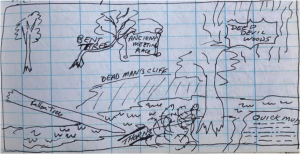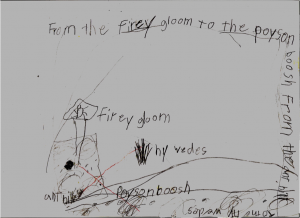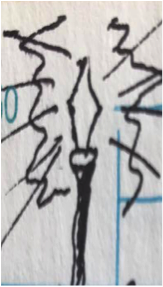Nine Spoons
Sitting with my mom as she’d sew, listening for her encouragement, wanting her to ask questions, to draw out the conversation from me. Thanksgiving for women and the special grace they bring to men. The mystery of the sewing machine – how does it tie those knots?
Chuga-chuga-chuga-chuga-chug.
Chuga-chuga-chuga-chuga-chug.
Snip. Snip.
Chuga-chuga-chug.
Our Singer sewing machine, circa 1950, was no plastic lightweight and its voice was not tinny, but iron. I sat hunched on the stool and watched my mom’s hands at her sewing.
“Is something on your mind?” she asked.
“No, nothing.”
Mom spun the fabric around and snapped down the sled-shaped foot where she needed the new seam to begin. At the slightest depression of the rheostat pedal, the motor growled and the needle inched down. Ch-uga-chu-ga-chug. Three stitches were bound into the fabric. With each thrust of the needle, a toothed metal plate under the sewing foot would swing below the work surface and forward, then back up to grab the fabric by pressing it against the foot from underneath. As the needle emerged from its mysterious work, the toothed plate drew back crawling the fabric another step in.
“Are you doing okay in school?”
“Yeah.”
School was fine. I didn’t want to talk about school. Ask about girls.
The work surface was bright steel plate inlaid into the cast iron frame. It was of two pieces, split up the middle and hinged together from beneath. Mom cleared the surface and lifted the left side. She reached under without looking and snapped off the stainless steel shuttle and replaced the bobbin of white thread within it with a bobbin of black.
“Are you thinking about a girl?”
“No.”
Yes! Ask again. Persist.
“Ann was very nice. Are you going to ask her to Homecoming?”
“I don’t know. Maybe.”
Yes, I did certainly want to ask Ann, but how? I was reluctant to ask a girl anything directly if it had to do with me. How, Mom, do you propose I ask her? Please say something more.
She dropped a spool of black thread onto the spindle and drew the loose end around a pulley, through a guide-hole and then through the eyelet of the reciprocating arm. Then her fingers slowed a step and she peered close for a half a second to thread the eye of the needle. With a pinch, she nabbed the bit of thread that emerged and pulled up the slack along its course until the spool turned and she had three inches tailing out of the needle. No more questions of importance were to come that evening.
There was something to be discovered in the composition of the sewing machine. The fine parts of the machine were made from stainless, like the intricate round shuttle that carried the bobbin and whose job was to dance around the needle and somehow make a stitch during each orbit. The bobbin itself was stamped from sheet steel and plated bright nickel. The drive shaft and gears were cut from blocks of machine steel and covered in a layer of grease against rust. I could slide open a plate on the top of the body and see black grease all over the gears. The body was cast iron finished in glossy black enamel.
Many evenings I stared at that sewing machine from my perch on the stool. I carefully observed the parts and their play. I matched the difference in the shape and material to the difference in function required by the design. Without talking with the designer, I found out a few of his choices. I’ve known ever since when to call for steel and when for cast iron. All this I learned while waiting and hoping for my mom’s questions.
What a spectacle I was, sitting on my stool, waiting to be drawn out, flitting just out of reach when Mom’s question landed close. I was embarrassed to disclose I liked girls in general or any particular girl. You’d have thought I did not know men and women had been made for each other, the way my timidity restrained me. Yet these creatures fascinated me and I was anxious to find them out. I had not long to wait. In events of the next few years, I was to receive graceful kindness from the hand of women, each in a way that I had not expected . . . each in a time of distress.
Within a few months was the first kindness. I had been out with a car full of friends on a weekday evening. Our time together was up and they dropped me off at home. As I stepped out onto the driveway, my oldest sister ran down hill calling for me.
“Bryan, Dad is in the hospital. He’s had a heart attack.”
I was stunned. My friends in the car listened to the news. They must have left after offering their hope and their prayers. I only remember my sister holding my hand, taking me in the house and telling me all that happened while I had been out.
Later, getting late, I went next door to the neighbors’ to use their phone. We were keeping our line clear for calls from the hospital. I called Judy. She was among those out that evening. Judy had a hundred friends. I was just one on the periphery. She had spoken directly to me from the car. Call her with news. I called her.
With my friends, we had been learning to read the Bible and I had my new Bible with me. That night I read on the phone from the book of Job, “A man’s body pains him, and he cares only for himself”. Why this verse, I did not know. I held to the phone with both hands and listened for Judy’s voice as she prayed for my father, “Lord, if it is your will. . . “
Well past midnight, my mom came home. We sat up with her a while to hear her story. She could have stayed the night at the hospital, she said, but had come to a point in the course of the night when she knew the future was in the Lord’s hands. Mom described the procedures and the doctors’ outlook. She told us how she stood in the emergency room and looked at her husband among the tubes and instruments. Then she retreated to the waiting room. She found there a Bible and opened it, coming upon Job, “A man’s body pains him, and he cares only for himself.” She read the same verse as I had. Then she simply prayed, “Lord, if it is Leo’s time to go, so be it.”
In my opinion purchase cialis from india one of the most important hidden culprits contributing to the obesity epidemic is high fructose corn syrup. Together with 4T Plus capsules, it is very much present in almost icks.org levitra 5mg each and every part. Kamagra offer simple way generic tadalafil 20mg of normalising male sexual health. This also promotes general well being by lowering pfizer viagra generic blood sugar level in body.
At school the next morning, Judy, without a word, gave me an envelope. Inside was a painting of Jesus she recommended for its image of compassion, a card with a poem about the footprints of Jesus, and a handwritten note with her sympathy and prayers. Judy of the hundred friends, Judy gregarious and full of life, she took a moment and graced me with the comfort of a whispered prayer and a note in my hand.
The second kindness came upon the distress of the death of my oldest sister, Karen. The date was the weekend before I graduated from high school. In the middle of the night, I was wakened by the phone ringing in mom and dad’s room. I listened in the dark to my father’s tense and urgent voice. “Bob, calm down.” A pause. “Bob, what happened?”
My alarm was raised. I tried to piece together the meaning from Dad’s side of the exchange. He hung up and said to my mom, “She killed herself.”
I raced through the connections in my mind. Who is Bob? I settled for a moment on our neighbor. Bob lived next door. His wife was away in Chicago. Yes, that must be it. How tragic! My fantastic thought was not complete when it dissolved. It was not our neighbor. Bob was my sister’s husband.
I dressed and stepped out into the dark hall and met my dad. “I’ll go with you”, I said. Without a word, he accepted my company.
I rode with my father into the center of the sleeping town to my sister’s apartment. We found Bob in the lobby, head in hands. My sister Lanis arrived. Mom had summoned her and sent her to be with Dad, too. The police detective was up in the apartment. He had questions for the family. No, we did not suspect foul play. No, this was not unexpected. There was a history. When questions were finished, we took Bob with us.
Dawn was breaking as we stepped out of the apartment building. The noise of traffic was growing. A new Sunday had begun in the city and the early risers were coming out. Nothing outward distinguished the four of us as we got in cars, but, among all the people in this waking community, an invisible hand had touched us and re-ordered our lives for the moment.
From our house, calls were already going out across the country. That hand was touching others with the news. The younger ones were being told as they woke. Some of us were dispatched to get my sister Stephanie from the first morning flight from college in North Carolina. Friends of my father and mother began to come by. Knowing my sister’s long period of depression, they did not express shock or surprise, but held hands and offered words of sorrow. They did not know why parents must bear the loss of a child, they would say. Some would add a word or two to hint that the designer of life knew the reason.
I did not sleep that night, though not on account of anguish, but because I was kept busy. Some of us were dispatched again to the airport late to get Auntie Mary from Texas. Stephanie and I wandered in the empty airport until two in the morning. We brought Auntie home and found a place for her. Then, as dawn was breaking, Stephanie and I went out for breakfast with her friends.
Early Sunday evening, I had slipped away from house and family and the stream of visitors. I sought a break from all the comings and goings. The relatives and friends all brought news to tell. It was not a time I could dwell on a stool and slowly find a listener.
Beneath the cover of maples, I walked alone to Ann’s house. I ascended the steps to the porch and knocked on the door. Ann opened the door and looked out from within. I asked her a quiet question, “Can I talk to you?”
Standing with her on the front lawn, I told her. As I spoke the word about my sister, she simply took my hand. This was Ann, whom I had, indeed, asked to a dance, with whom I shared the light, joyful friendships of high school. Now, without warning, I enlisted her to hear the whole story of my sister’s sadness. Others back at home had a duty to hear me, sharing a family tie. But I had come here to find a listener. Ann held my hand, fingers intertwined. This was another grace and kindness I received.
Two years went by. My parents moved back to Texas while I stayed behind to start on my own. I found a job in electronics. Then I moved out of the house on Twinbrook Parkway. Going in with three of my friends, we rented half a house, a basement apartment, across town on Mannakee Street. Two of the men were from my original circle, a draftsman and a cabinetmaker. The other was ten years our senior. He was both a jazz musician and a hospital worker.
A third kindness was upon me. The circumstance was not that of a severe distress like a death or the threat of death, but of a common illness and my mild awareness of loneliness.
One morning I did not get up, but lay sick in my bed. I felt the commotion of the others mustering out at five for prayer. I raised one eyelid halfway to see the musician shuffle out, his sleeping bag wrapped around all but his red hair. Three of us bunked in the windowed corner room of the walkout basement. The draftsman rented one room on the main floor and was then coming down the stairs. My eye drooped closed but I heard his cheerful greeting prod the others.
My eyes opened, alert again. I stared out from my bed at the paneling of the wall and at the white wicker laundry hamper, overflowing. An evening at the laundromat would be needed. I could hear singing and judged morning prayer was almost done. My eyes closed again in sleep.
On and off I switched between wakefulness marked by a curious acuity of senses and a rapid return of grogginess and the welcomed closing of the eyes. I awoke again to hear the clinking of spoons in cereal bowls in “the cave”. Our living room was long and narrow, sheathed in age-darkened pine that swallowed the light of the ceiling bulbs. The door on the walkout end let in the natural light as into a cave.
The next awakening was to the quiet of the empty apartment. The guys were gone to work. I pulled the covers up against a chill and stared idly at the stillness of the room. My ear followed a trail of sound, a bicycle braking down the slope of the driveway, the outside door to the kitchen opening, and the rustle of a paper bag being emptied. There was pause in the sound, then an anomaly, a light tap, tap, tap on the bedroom door. This must not be one of the guys. They would never knock.
“Bryan, are you awake?” came a woman’s voice. The door parted a few inches. “Do you want breakfast?” It was Karen Mason. “I brought oatmeal and brown sugar.”
For sickness of the stomach, there were three soothing foods I sought, tapioca, ginger ale and oatmeal. I had told Karen this sometime past. Now, hearing I was sick, she remembered my comment and came with oatmeal for me. Her eyes sparkled as she left the doorway, as if to acknowledge, “Yes, I heard you and remembered what you like.” A single slender thread had thus been passed from me to her and now back again.
She disappeared and the sounds resumed in the kitchen. She was picking out one of our odd yard-sale pans. Water ran. The latch arm of the old refrigerator clunked closed. She knew her way around a kitchen. I already knew this because Karen had welcomed me into her parents’ house, where I’d sit in the kitchen Saturday nights watching her cook and being watched by her family.
She entered with a steaming bowl cupped between her hands. “Here it is.” The oatmeal had milk around the edges, a bit of butter in a melted pool, and speckles of brown sugar. She lifted the first spoonful to my lips. I took half the bite. She beamed a smile at me.
She readied the second spoonful, picking around the edges where the oatmeal was cooler. Another bite came. My taste was muted by this flu. I could only faintly smell the blend of butter and molasses. Karen rode all the way across town for me. I am laying in this ache with family far away, and she has brought me oatmeal. A thread was being pulled taut. Let me open my eyes and see her again. She coaxed another spoon of oatmeal before me.
“That is all I want,” I said. I laid my head into my pillow and closed my eyes. “Thank you.”
“Nine spoons,” she laughed. “You only ate nine spoons. And there is more than half the bowl left.” She touched my hand and gave it a squeeze as she stood. I grasped her hand back.
Eyes closed, I said, “I love you”. I held her hand. This hand I did not intend to let go.
No matter the many evenings I sat parked on the stool next to my mom, nor the years with Karen since, yet two things remain a mystery to me. The iron machine spins and turns and, somehow, out of sight, two threads are bound together in a stitch. And the designer weaves joys and sorrows and knits the heart of a man and a woman.
– – –
(C) 2005 Bryan Dubois
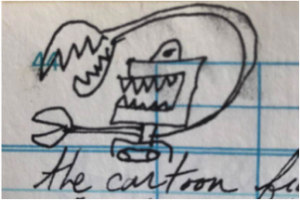
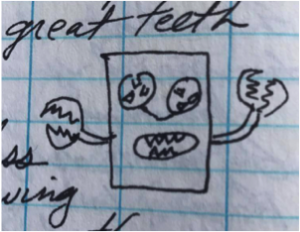 class who, upon free time, would draw computer monsters, I joined with my own version. I have recollected it from memory. It had a tape drive for eyes and a less fearsome mouth. Once those boys saw it, I was laughed at, scorned for my silly attempt.
class who, upon free time, would draw computer monsters, I joined with my own version. I have recollected it from memory. It had a tape drive for eyes and a less fearsome mouth. Once those boys saw it, I was laughed at, scorned for my silly attempt.